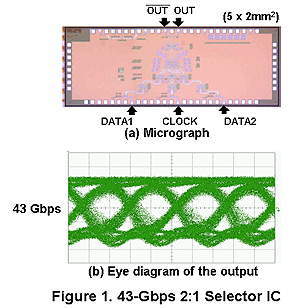
 |
|
|
|
|
|
Fujitsu Develops World's First CMOS Selector Chip Operating at 50 GbpsTokyo, March 23, 2004 -- Fujitsu Laboratories Ltd. and Fujitsu Limited today announced the development of a selector chip (*1) using Fujitsu's CMOS technology capable of record-breaking 50-Gbps throughput. The new technology delivers the benefits of a highly integrated, low-power design in CMOS with the 40-Gbps performance levels required for devices used in high-bandwidth data communications, speeds that previously could only be attained using silicon-germanium chips or other compound semiconductors. This technology represents a breakthrough in achieving the 40-Gbps throughput levels required of devices for next-generation telecommunications. Details of the new technology were presented last month at the International Solid-State Circuit Conference. BackgroundWith the ongoing spread of broadband Internet access, there is a growing need for networks that can deliver higher speeds and bandwidth capacity. Although the current standard is 10 Gbps, next-generation network systems need to be able to run at 40 Gbps. Reaching those speeds will require ultra-fast chips that can process data at rates of at least 40 Gbps, and most development work has focused on silicon-germanium and other compound semiconductors that offer superior speed characteristics. Technological ChallengesBut while devices using silicon-germanium or other compound semiconductors can offer superior speed, they consume very high levels of power, posing heat problems for highly integrated designs, and are expensive in terms of manufacturing costs. CMOS chips, on the other hand, consume less energy and cost less, but the transistor characteristics and interconnect parasitic capacitances of CMOS chips have-with the approaches pursued up until now-made it difficult achieve speeds exceeding 40 Gbps. Fujitsu's TechnologyFujitsu's new technology enables CMOS circuits to operate faster. With a new circuit schematic employing inductors (*2) and cutting-edge 90-nm CMOS technology, Fujitsu was able to achieve a dramatic increase in processor throughput. The key features of the new technology are as follows:
Fujitsu developed two selector chips with different circuit schematics using this technology, achieving throughput of 43 Gbps and 50 Gbps, respectively (see Figures 1 and 2). This is the first time that chips using CMOS technology have verifiably achieved operating speeds in excess of 40 Gbps. The selector chip operating at 50 Gbps uses a circuit schematic that takes 1.0V power, standard for 90-nm CMOS chips, and would be relatively easy to develop into large-scale system-on-chip devices. Future DevelopmentsFujitsu is currently developing large-scale system-on-chip devices incorporating this technology, aiming for commercial release some time around 2006 to 2007.   Notes
About Fujitsu About Fujitsu
All company/product names mentioned may be trademarks or registered trademarks of their respective holders and are used for identification purpose only. |
|
|